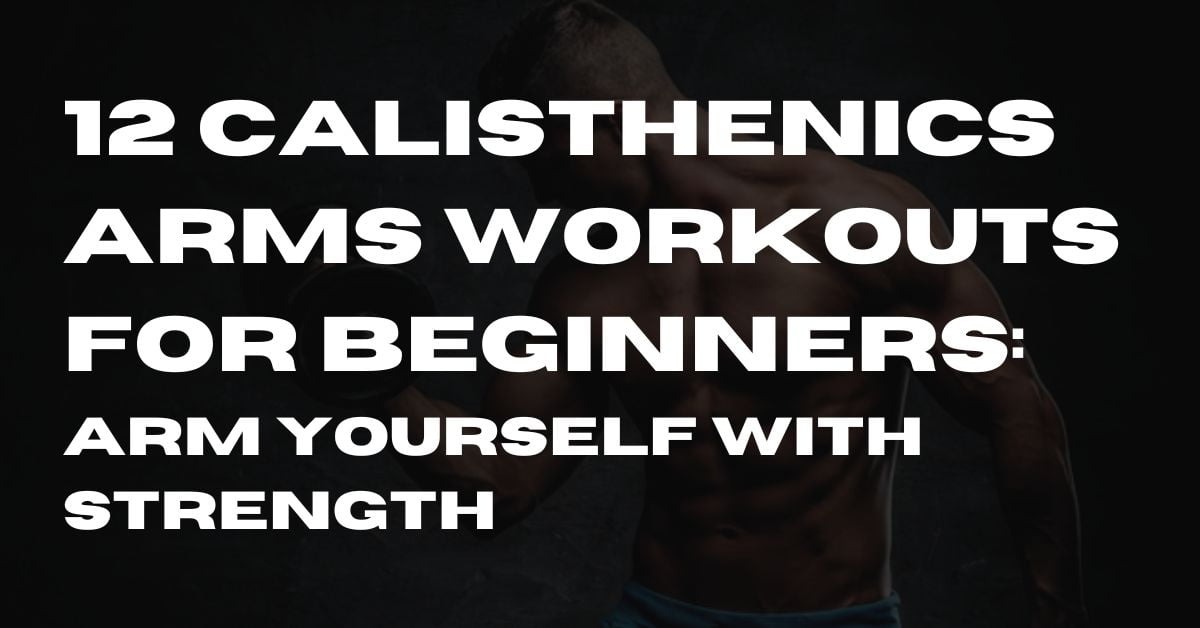Are you prepared to embark on a voyage to sculpt your arms, yet uncertain about the initial steps? Well, you’re in for a delightful experience.
Our guide, “12 calisthenics arm workouts for beginners,” serves as your comprehensive solution to kickstart your fitness journey and transform those arms into veritable fortresses of power.
Whether you are a beginner to exercise or simply looking to diversify your routine, we’ve got you covered.
Bid farewell to intimidating gym equipment and welcome bodyweight exercises that you can perform anywhere and at any time.
Let’s plunge into the world of calisthenics and uncover how it can manifest your fitness aspirations.
Table of Contents
Understanding The World of Calisthenics
What is Calisthenics?
Discover the world of calisthenics, a workout regimen that doesn’t require costly gym memberships or elaborate equipment.
Calisthenics, often referred to as “bodyweight training,” is a versatile and accessible exercise method that leverages your body’s weight as a resistance tool, fostering strength, flexibility, and endurance.
Calisthenics workouts encompass a wide range of movements, including push-ups, pull-ups, squats, and planks, all targeting various muscle groups.
This comprehensive approach not only builds functional strength but also elevates overall athletic performance.
The beauty of calisthenics lies in its simplicity and adaptability.
Whether you’re a beginner or an experienced athlete, calisthenics offers a scalable and effective way to maintain physical fitness.
You can customize your routine to match your fitness level, making it suitable for a diverse range of individuals.
For a deeper understanding of calisthenics, consult reputable sources like Respiratory Care and Bodybuilding.com. These sources provide expert insights and well-researched information.
Whether your goals involve muscle building, increased flexibility, or simply leading a healthier lifestyle, calisthenics can open the door to a fitter, stronger version of yourself.
Avoid common mistakes in your calisthenics workout routine and make the most of this accessible and effective approach to fitness.
Why Choose Calisthenics for Arms Workout?
Are you in search of a potent and accessible means to chisel the sculpted arms you’ve perpetually yearned for?
Enter calisthenics – your clandestine weapon for fostering impressive arm vigor and definition.
Yet, what attributes render calisthenics the preferred choice for arm-centric workouts?
Calisthenics capitalizes on the potency of your body’s weight, rendering it a versatile and equipment-independent alternative.
Irrespective of whether you are a novice or a fitness enthusiast, calisthenics presents a broad array of arm-focused exercises that can be customized to dovetail with your fitness proficiency.
One of the pivotal advantages of calisthenics is its capacity to concurrently involve multiple muscle groups.
When executing exercises such as push-ups, dips, and planks, your arms merely serve as the tip of the proverbial iceberg.
Your core, shoulders, and chest all partake in the effort, bestowing upon you a well-rounded upper-body workout.
Warm-up Routine
Visualize this scenario: You stand poised to commence your fitness journey, ready to conquer your workout regimen.
However, before plunging into these strenuous exercises, there exists a crucial ritual you should not overlook – your warm-up routine.
What elevates the significance of warming up?
Picture your muscles as elastic bands. When they remain cold, they possess rigidity and are susceptible to snapping.
Yet, with a proper warm-up, you gently extend and prepare these muscles for exertion, thereby diminishing the risk of injury and enabling peak performance.
So, let’s embark on the journey of priming you for triumph with a straightforward yet efficacious warm-up regimen.
These exercises not only augment your flexibility but also accelerate your heart rate, ensuring that you are primed to tackle any challenges that lie in waiting.
Warm-up Exercises:
- Jumping Jacks: Initiate with 30 seconds of these timeless maneuvers. They will stimulate your circulation and elevate your body temperature.
- Arm Circles: Assume a stance with your feet positioned shoulder-width apart and extend your arms horizontally. Commence crafting small circles with your arms, progressively amplifying their diameter over a 30-second duration.
- Leg Swings: Grasp a stable surface and gently swing one leg forward and backward for 15 seconds, subsequently alternating to the other leg. This facilitates the loosening of your hip flexors and hamstrings.
- Bodyweight Squats: Execute 10-15 squats to engage your lower body and prepare your legs for more demanding movements.
- Dynamic Lunges: Advance a step forward into a lunge, then return to the initial position. Repeat this motion for both legs, performing 10 repetitions for each leg to invigorate your leg muscles and enhance hip flexibility.
- Plank to Downward Dog: Initiate from a plank posture, then elevate your hips to create an inverted “V” configuration. Maintain this position briefly before reverting to the plank stance. Recur this sequence five times to activate your core and extend your hamstrings.
- High Knees: March in place, lifting your knees as high as possible for 30 seconds. This heightens your heart rate and prepares your leg muscles for activity.
The 12 Calisthenics Arm Workouts
1. Push-Ups
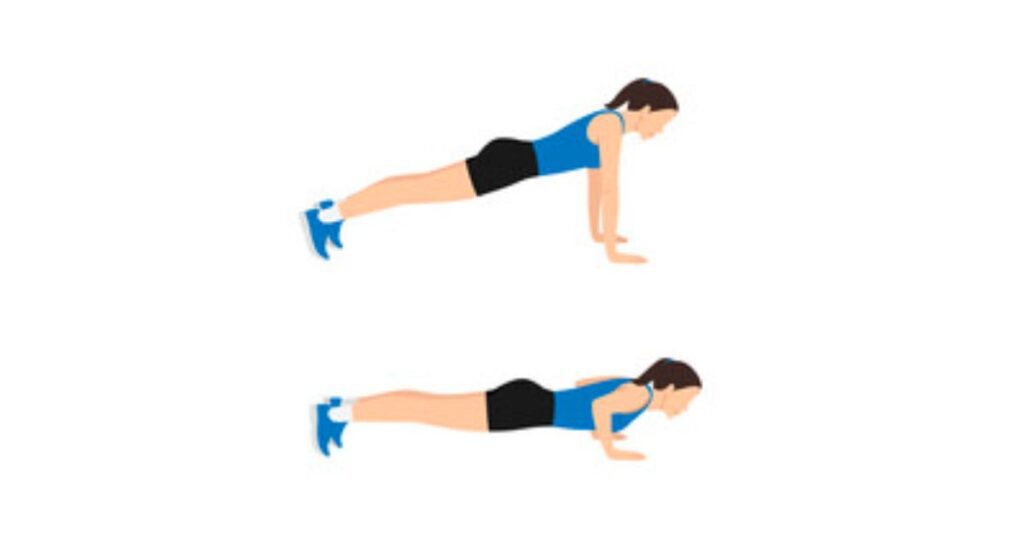
Steps:
- Start in a plank position with your hands placed slightly wider than shoulder-width apart.
- Lower your body by bending your elbows, keeping them close to your body.
- Push back up to the starting position, fully extending your arms.
Benefits:
- Builds chest, shoulder, and tricep strength.
- Engages your core for stability.
- Improves overall upper body endurance.
2. Diamond Push-Ups
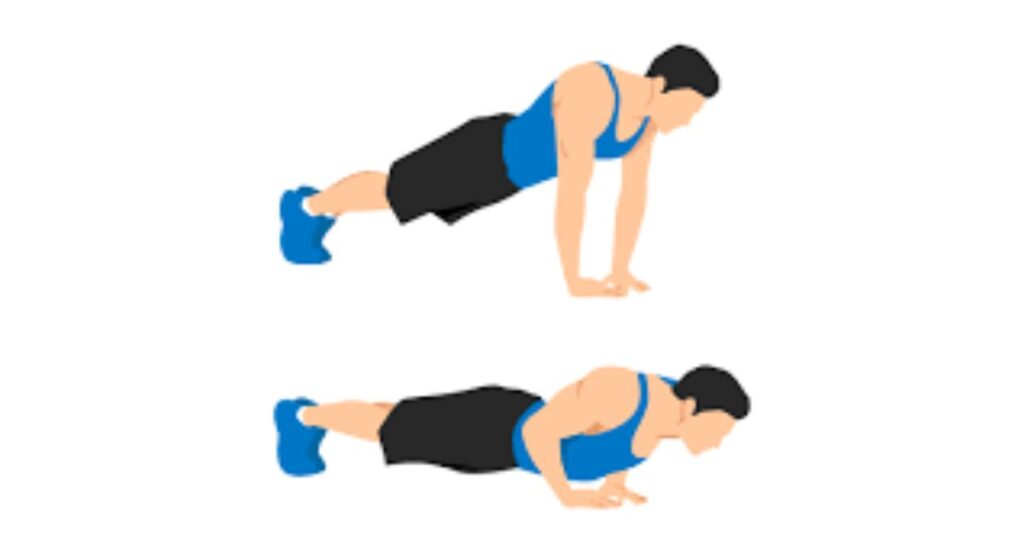
Steps:
- Begin in a plank position, but place your hands close together under your chest, forming a diamond shape with your thumbs and index fingers.
- Lower your body, maintaining the diamond shape with your hands.
- Push back up to the starting position.
Benefits:
- Focuses on triceps, making them stronger and more defined.
- Enhances chest and shoulder muscle engagement.
- Increases triceps endurance.
3. Triceps Dips
Steps:
- Sit on the edge of a sturdy chair or bench with your hands gripping the edge beside your hips.
- Extend your legs out in front of you.
- Lower your body by bending your elbows to about a 90-degree angle.
- Push yourself back up to the starting position.
Benefits:
- Isolates and strengthens the triceps.
- Enhances stability in the shoulders and upper body.
- Helps with overall arm definition.
4. Plank Shoulder Taps

Steps:
- Begin in a plank position with your wrists directly under your shoulders.
- While maintaining a stable core, lift one hand and tap the opposite shoulder.
- Alternate tapping shoulders, maintaining a strong plank position.
Benefits:
- Strengthens the entire core, including the obliques.
- Improves shoulder stability and strength.
- Enhances balance and coordination.
5. Arm Circles
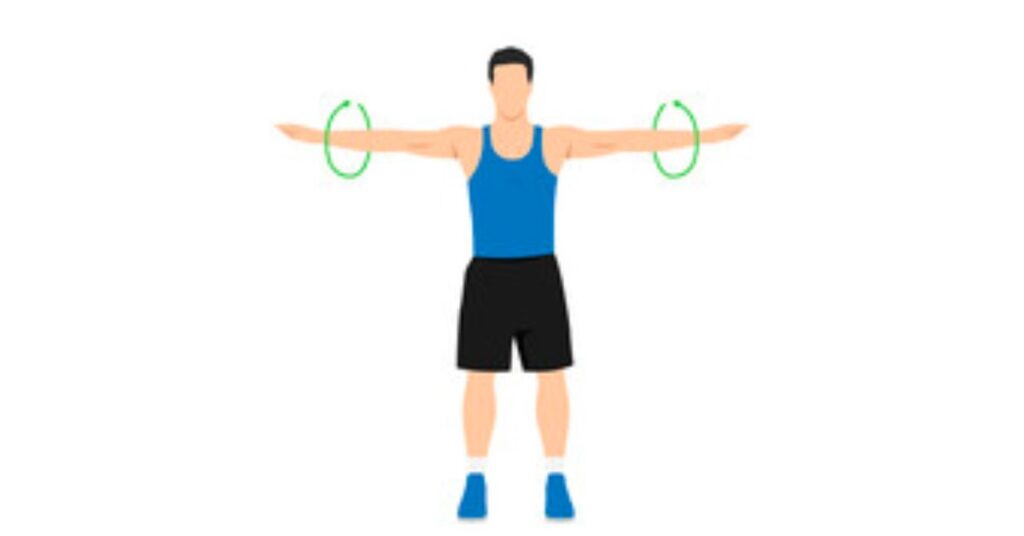
Steps:
- Stand with your feet shoulder-width apart and extend your arms to the sides.
- Make small circles with your arms, gradually increasing their size.
- After a set time or repetitions, reverse the direction of the circles.
Benefits:
- Warms up shoulder joints and improves mobility.
- Helps prevent shoulder injuries.
- Great for shoulder flexibility.
6. Wall Push-Ups
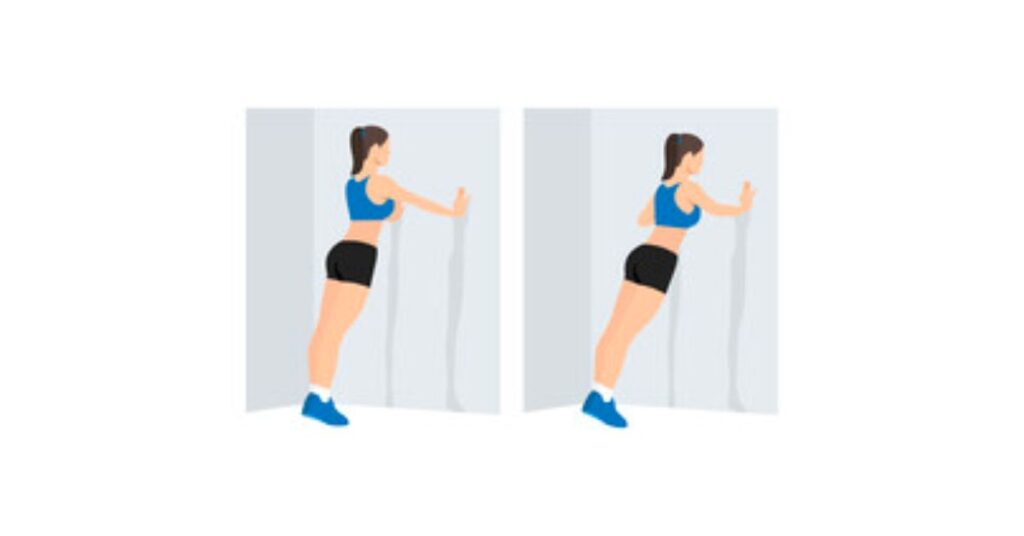
Steps:
- Stand facing a wall, arms extended and palms on the wall at shoulder height.
- Lean into the wall, bending your elbows to bring your chest closer to the wall.
- Push back to the starting position.
Benefits:
- Ideal for beginners as it reduces body weight resistance.
- Builds chest, shoulder, and tricep strength.
- A great way to progress to standard push-ups.
7. Isometric Bicep Hold
Steps:
- Stand with your arms bent at a 90-degree angle, fists clenched.
- Hold this position, keeping your biceps contracted and arms static.
Benefits:
- Isolates the biceps for targeted strengthening.
- Enhances endurance in the bicep muscles.
- Requires no equipment and can be done anywhere.
8. Bodyweight Bicep Curls
Steps:
- Stand with your feet shoulder-width apart.
- Hold your arms straight down at your sides, palms facing forward.
- Slowly bend your elbows to curl your hands toward your shoulders.
- Lower your hands back down to the starting position.
Benefits:
- Strengthens the biceps without the need for weights.
- Enhances bicep endurance.
- Improves arm aesthetics and definition.
9. Chair Dips
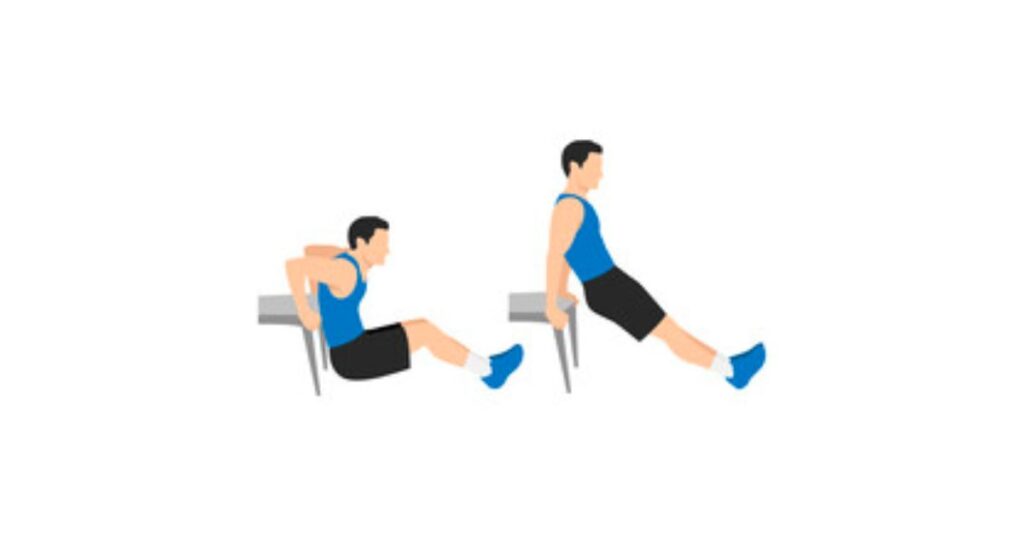
Steps:
- Sit on the edge of a sturdy chair or bench with your hands gripping the edge beside your hips.
- Extend your legs out in front of you.
- Lower your body by bending your elbows to about a 90-degree angle.
- Push yourself back up to the starting position.
Benefits:
- Focuses on triceps and shoulder strength.
- Increases upper body stability.
- Aids in building tricep definition.
10. Inchworms
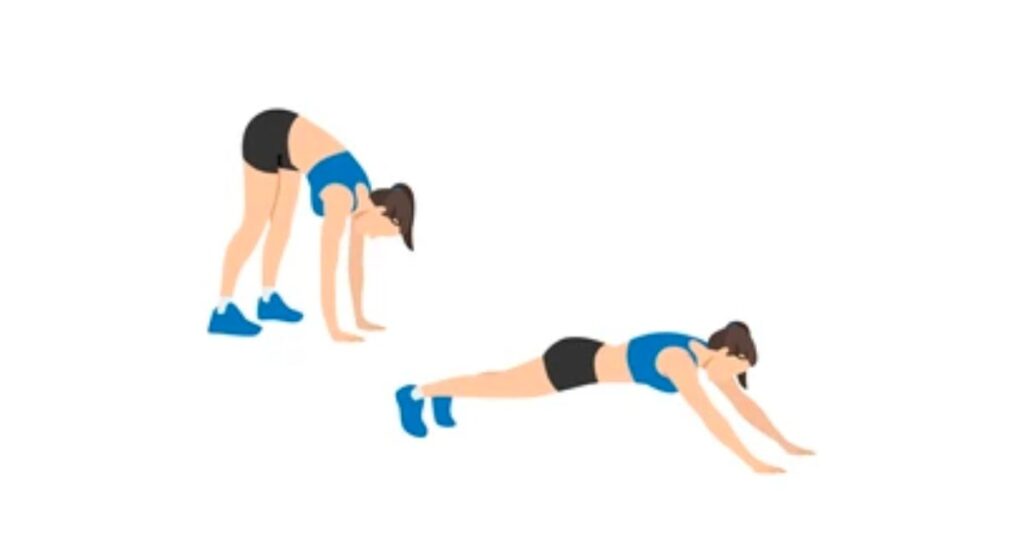
Steps:
- Stand with your feet hip-width apart.
- Bend at the waist and reach your hands towards the floor, keeping your legs straight.
- Walk your hands forward into a plank position.
- Walk your feet towards your hands, returning to the starting position.
Benefits:
- Stretches the hamstrings and lower back.
- Engages the core muscles.
- Enhances overall body flexibility.
11. Bicep Curls (Using a Towel)
Steps:
- Stand with your feet shoulder-width apart, holding a towel in both hands.
- Tuck the towel under your right foot and hold the ends with your right hand.
- Keeping your elbow close to your body, curl the towel upward, bringing your hand toward your shoulder.
- Lower the towel back down to the starting position.
- Repeat for the desired number of repetitions on your right side, then switch to your left.
Benefits:
- Targets and strengthens the biceps.
- Provides a unique challenge by using a towel for resistance.
- Improves grip strength and forearm stability.
12. Burpees
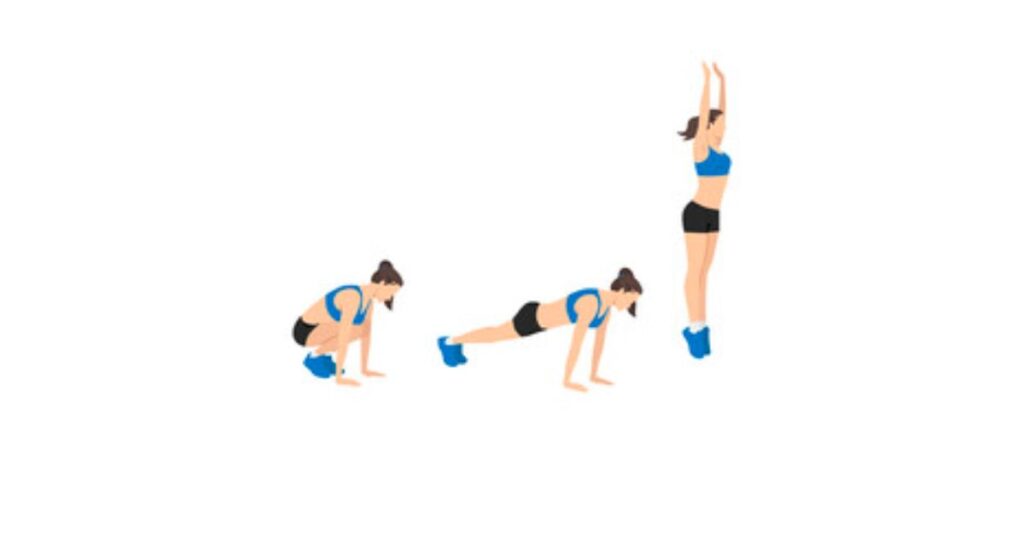
Steps:
- Begin in a standing position.
- Drop into a squat position with your hands on the ground.
- Kick your feet back into a plank position.
- Quickly return to the squat position.
- Explode upward, jumping as high as you can with your arms reaching overhead.
Benefits:
- A full-body exercise that elevates heart rate.
- Strengthens the arms, chest, and legs.
- Boosts cardiovascular endurance and burns calories.
Creating a Workout Routine with Calisthenics Arm Exercises
So, you’ve got the arsenal of fantastic calisthenics arm exercises at your fingertips, but how do you bring them together into an effective workout routine?
It’s time to craft a plan that will help you achieve those strong, sculpted arms you’ve been dreaming of.
Warm-Up (5-10 minutes):
Begin with a dynamic warm-up that includes exercises like jumping jacks, arm circles, and leg swings to get your blood flowing and your muscles ready for action.
Main Workout (20-30 minutes):
Push-Ups (3 sets of 10 reps):
- Start with the classic push-up to engage your chest, shoulders, and triceps. Gradually increase the sets and reps as you progress.
Diamond Push-Ups (2 sets of 8 reps):
- Move on to diamond push-ups for a more intense triceps workout. Adjust the number of sets and reps to match your fitness level.
Triceps Dips (3 sets of 12 reps):
- Shift to triceps dips using a sturdy chair or bench. Feel the burn in those triceps as you complete each set.
Plank Shoulder Taps (2 sets of 10 taps per side):
- Challenge your core and shoulders with plank shoulder taps. Focus on stability and control during each tap.
Bodyweight Bicep Curls (3 sets of 12 reps):
- Work on your biceps by adding bodyweight bicep curls to the mix. Adjust sets and reps as needed.
Chair Dips (2 sets of 10 reps):
- Return to chair dips to give your triceps another round of attention. Remember, form is key to effectiveness.
Cool-Down (5-10 minutes):
- Finish your workout with static stretches for your arms, shoulders, and chest. Hold each stretch for 15-30 seconds to improve flexibility and reduce muscle soreness.
Tips for Arm Workout Success
When it comes to sculpting those dream-worthy arms, consistency, and smart choices are your allies. Here are some real-world, no-nonsense tips to ensure your arm workout journey is a success:
- Start Slow, Build Steady: Rome wasn’t built in a day, and neither are those biceps. Begin with exercises that match your fitness level and gradually increase the intensity over time.
- Proper Form Trumps All: It’s not about how many reps you do; it’s about how well you do them. Ensure your form is spot on for each exercise to avoid injuries and maximize results.
- Rest and Recovery: Don’t underestimate the power of rest. Muscles need time to repair and grow stronger. Give yourself 48 hours between intense arm workouts to allow proper recovery.
- Balanced Diet Matters: Exercise is just one part of the equation. Fuel your body with a balanced diet rich in protein, healthy fats, and carbohydrates to support muscle growth and overall health.
- Stay Hydrated: Dehydration can hinder your workout performance. Drink plenty of water before, during, and after your sessions to keep your muscles functioning at their best.
- Listen to Your Body: If something doesn’t feel right, stop immediately. Pushing through pain is a recipe for injury. Pay attention to your body’s signals and adjust your workouts accordingly.
- Variety is Key: Keep your workouts interesting by incorporating a variety of exercises. This not only prevents boredom but also ensures you’re working different muscle groups for a well-rounded arm workout.
- Track Your Progress: Maintain a workout journal or use fitness apps to track your sets, reps, and progress. Seeing your improvements over time can be incredibly motivating.
- Don’t Neglect Cardio: Cardiovascular fitness complements your strength training. Incorporate some form of cardio into your routine to boost overall fitness and fat loss.
- Consistency is King: The most significant factor in achieving your arm goals is consistency. Stick to your workout routine, even on days when motivation is low.
Conclusion
You’ve just uncovered the secrets to building stronger, more defined arms through the power of calisthenics.
Armed with an array of effective exercises and a solid workout routine, you’re on the path to success.
But remember, your journey is not just about aesthetics; it’s about becoming a healthier, more confident version of yourself.
So, stay consistent, embrace the challenge, and enjoy the journey. Your arms will thank you, and so will your overall well-being.
So, what are you waiting for?
Roll up those sleeves and start your calisthenics arm workout adventure today.
Flex those muscles with pride and let your newfound strength become a symbol of your dedication and determination.
The world is your gym; go out there and conquer it.

